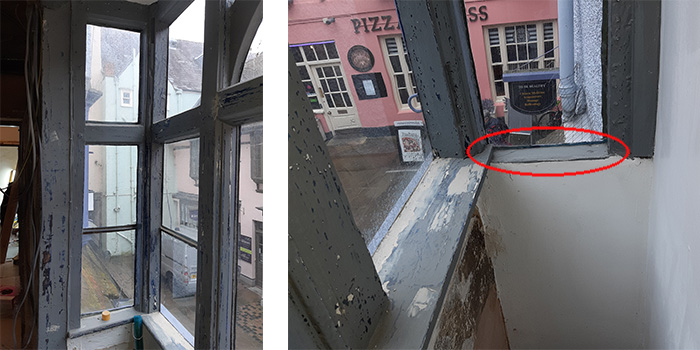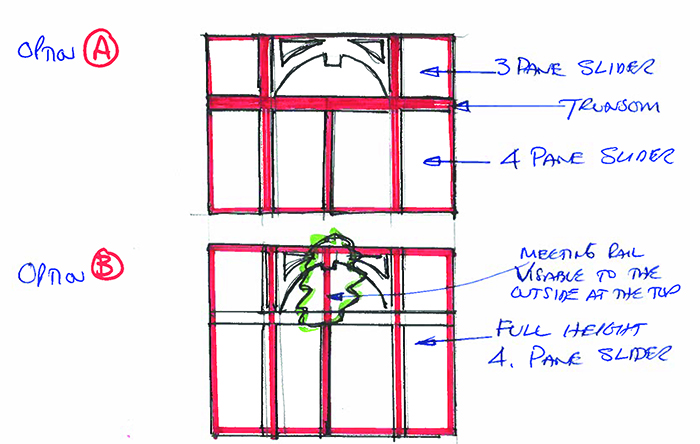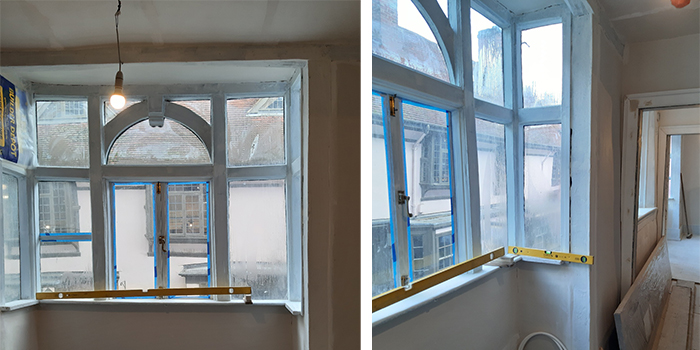The main objective when installing secondary glazing is to match the sightlines of the primary windows as discreetly and effectively as possible. However, this 14th century building induced some head-scratching and a great deal of time in planning the treatment to make it is as seamless as possible. On first inspection – we were not even sure if it would be possible, although necessary to help raise the thermal performance of the Grade I Listed originals which could not be changed.
The first thing that struck the Technical Advisor on the initial visit, was the lack of reveal in the tight bays, especially in the areas of the bay posts, which would mean that there would be no room for the secondary glazing timber grounds to be fixed. One cill was missing completely, so the main contractors working on the project restored and extended the cills to facilitate the installation of the internal windows.
 Narrow reveals and missing cill board
Nothing in the room was straight – the ceilings and floors were sloping, the bays had obviously moved and dropped over time, however to the naked eye it wasn’t evident quite how much. Dimensions were taken and handed over to the project surveyor with the final design option on how to treat the windows.
Narrow reveals and missing cill board
Nothing in the room was straight – the ceilings and floors were sloping, the bays had obviously moved and dropped over time, however to the naked eye it wasn’t evident quite how much. Dimensions were taken and handed over to the project surveyor with the final design option on how to treat the windows.
 Design options put forward – Option A was decided on as the least obtrusive
Armed with the initial details, further visits to site were made to assess just how un-true and out of plumb the bays were; to see if the proposed treatment would work, or if it would be too much of a fight between the secondary glazing, space and sightlines.
Design options put forward – Option A was decided on as the least obtrusive
Armed with the initial details, further visits to site were made to assess just how un-true and out of plumb the bays were; to see if the proposed treatment would work, or if it would be too much of a fight between the secondary glazing, space and sightlines.
 Spirit levels showing how much the bay had moved and uneven the cills were
Typically openings which are not level, plumb and true are made so with scribed timbers. In this instance the plan was to level the cill and use a face fix timber at the head, fixed to the window frame, to avoid the large bow in the lath and plaster ceiling. However, this would have meant an infringement on the glass sightlines of the original window, and indeed when the head timber was levelled through it would miss the original frame altogether. It was going to be a fight with the existing sightlines, but one that would be resolved!
After much assessment, it was decided that the only way to successfully install the secondary glazing, was to run the timber grounds with the bay lines and install the ‘square’ secondary glazing out of level, plumb and true, using the timber grounds to take up the now reduced deviations. During their installation, the head timbers needed scribing on site, to match the undulations in the lath and plaster ceiling. Builders squares were used to ensure the new timber grounds were ‘square’ to accept the new secondary glazing.
Spirit levels showing how much the bay had moved and uneven the cills were
Typically openings which are not level, plumb and true are made so with scribed timbers. In this instance the plan was to level the cill and use a face fix timber at the head, fixed to the window frame, to avoid the large bow in the lath and plaster ceiling. However, this would have meant an infringement on the glass sightlines of the original window, and indeed when the head timber was levelled through it would miss the original frame altogether. It was going to be a fight with the existing sightlines, but one that would be resolved!
After much assessment, it was decided that the only way to successfully install the secondary glazing, was to run the timber grounds with the bay lines and install the ‘square’ secondary glazing out of level, plumb and true, using the timber grounds to take up the now reduced deviations. During their installation, the head timbers needed scribing on site, to match the undulations in the lath and plaster ceiling. Builders squares were used to ensure the new timber grounds were ‘square’ to accept the new secondary glazing.
 Installation of the timber grounds with the builders square
It is rare that this approach is taken to install the secondary glazing out of alignment – untrue and un plumb to follow the original lines. Manufacturing measurements were taken post fixing of the timber grounds, to ensure an exact fit.
This extraordinary project taught the team a great deal and put up a good fight, but one that was won with a successful treatment and installation of secondary glazing, creating better thermal retention and a more comfortable living space for the occupiers.
Installation of the timber grounds with the builders square
It is rare that this approach is taken to install the secondary glazing out of alignment – untrue and un plumb to follow the original lines. Manufacturing measurements were taken post fixing of the timber grounds, to ensure an exact fit.
This extraordinary project taught the team a great deal and put up a good fight, but one that was won with a successful treatment and installation of secondary glazing, creating better thermal retention and a more comfortable living space for the occupiers.
 Narrow reveals and missing cill board
Nothing in the room was straight – the ceilings and floors were sloping, the bays had obviously moved and dropped over time, however to the naked eye it wasn’t evident quite how much. Dimensions were taken and handed over to the project surveyor with the final design option on how to treat the windows.
Narrow reveals and missing cill board
Nothing in the room was straight – the ceilings and floors were sloping, the bays had obviously moved and dropped over time, however to the naked eye it wasn’t evident quite how much. Dimensions were taken and handed over to the project surveyor with the final design option on how to treat the windows.
 Design options put forward – Option A was decided on as the least obtrusive
Armed with the initial details, further visits to site were made to assess just how un-true and out of plumb the bays were; to see if the proposed treatment would work, or if it would be too much of a fight between the secondary glazing, space and sightlines.
Design options put forward – Option A was decided on as the least obtrusive
Armed with the initial details, further visits to site were made to assess just how un-true and out of plumb the bays were; to see if the proposed treatment would work, or if it would be too much of a fight between the secondary glazing, space and sightlines.
 Spirit levels showing how much the bay had moved and uneven the cills were
Typically openings which are not level, plumb and true are made so with scribed timbers. In this instance the plan was to level the cill and use a face fix timber at the head, fixed to the window frame, to avoid the large bow in the lath and plaster ceiling. However, this would have meant an infringement on the glass sightlines of the original window, and indeed when the head timber was levelled through it would miss the original frame altogether. It was going to be a fight with the existing sightlines, but one that would be resolved!
After much assessment, it was decided that the only way to successfully install the secondary glazing, was to run the timber grounds with the bay lines and install the ‘square’ secondary glazing out of level, plumb and true, using the timber grounds to take up the now reduced deviations. During their installation, the head timbers needed scribing on site, to match the undulations in the lath and plaster ceiling. Builders squares were used to ensure the new timber grounds were ‘square’ to accept the new secondary glazing.
Spirit levels showing how much the bay had moved and uneven the cills were
Typically openings which are not level, plumb and true are made so with scribed timbers. In this instance the plan was to level the cill and use a face fix timber at the head, fixed to the window frame, to avoid the large bow in the lath and plaster ceiling. However, this would have meant an infringement on the glass sightlines of the original window, and indeed when the head timber was levelled through it would miss the original frame altogether. It was going to be a fight with the existing sightlines, but one that would be resolved!
After much assessment, it was decided that the only way to successfully install the secondary glazing, was to run the timber grounds with the bay lines and install the ‘square’ secondary glazing out of level, plumb and true, using the timber grounds to take up the now reduced deviations. During their installation, the head timbers needed scribing on site, to match the undulations in the lath and plaster ceiling. Builders squares were used to ensure the new timber grounds were ‘square’ to accept the new secondary glazing.
 Installation of the timber grounds with the builders square
It is rare that this approach is taken to install the secondary glazing out of alignment – untrue and un plumb to follow the original lines. Manufacturing measurements were taken post fixing of the timber grounds, to ensure an exact fit.
This extraordinary project taught the team a great deal and put up a good fight, but one that was won with a successful treatment and installation of secondary glazing, creating better thermal retention and a more comfortable living space for the occupiers.
Installation of the timber grounds with the builders square
It is rare that this approach is taken to install the secondary glazing out of alignment – untrue and un plumb to follow the original lines. Manufacturing measurements were taken post fixing of the timber grounds, to ensure an exact fit.
This extraordinary project taught the team a great deal and put up a good fight, but one that was won with a successful treatment and installation of secondary glazing, creating better thermal retention and a more comfortable living space for the occupiers.- Date
- Category
- Treat Of The Month